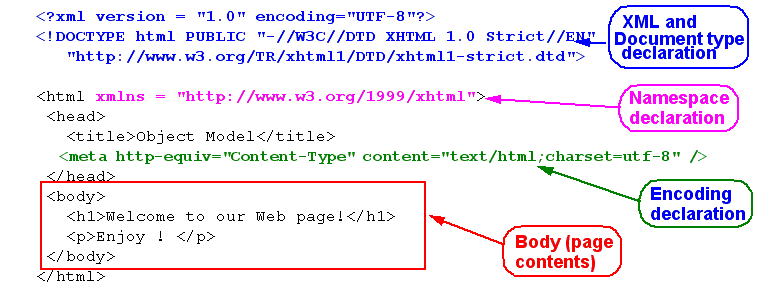XHTML: Difference between revisions
Jump to navigation
Jump to search
m (→On-line tools) |
mNo edit summary |
||
| Line 147: | Line 147: | ||
[[Category: XML]] | [[Category: XML]] | ||
[[Category: Document standards]] | [[Category: Document standards]] | ||
Revision as of 20:01, 8 July 2009
Definition
- XHTML is a family of current and future Web document types and modules that reproduce, subset, and extend HTML4.01. XHTML family document types are XML conformant, and designed to work in conjunction with XML-based editors and user agents.
See also: HTML and HTML links
XHTML documents
Valid XHTML documents
- XHTML documents must be wellformed and valid according to the XML specification, except that an XML declaration is not mandatory (only encouraged).
In addition:
- It must conform to the constraints expressed in one of the three variants (defined by DTDs)
- The root element of the document must be html
- The root element of the document must contain an xmlns declaration for the XHTML namespace. Examples:
<html xmlns= "http://www.w3.org/1999/xhtml" xml:lang="en" lang="en"> <h:html xmlns:h="http://www.w3.org/1999/xhtml" xml:lang="en" lang="en">
- There must be a DOCTYPE declaration in the document prior to the root element.
- The DTD subset must not be used to override any parameter entities in the DTD.
- An XML declaration on top of the file is mandatory if the character set used is different from UTF-8 or UTF-16.
XHTML Versions
- XHTML 1.0 (26 jan 2000, revised 1 Aug 2002)
- XHTML 1.0 transitional
- XHTML 1.0 strict
- XHTML 1.0 frameset
- XHTML 1.1 - Module-based XHTML
- XHTML Basic 1.1 is a mini-version of XHTML 1.0 for small devices (e.g. cell phones and PDAs). In principle, a successor for older WAP standards. Note there also exists a XHTML Mobile Profile which is a superset defined by the Open Mobile Alliance.
- XHTML 2.x
- There are many new features, e.g. HTML forms, frames and DOM events will be replaced by XML standards
- Any element can be a link
- Nested <section> elements with a single heading element will be added.
Example
<?xml version="1.0" encoding="UTF-8"?>
<!DOCTYPE html
PUBLIC "-//W3C//DTD XHTML 1.0 Strict//EN"
"http://www.w3.org/TR/xhtml1/DTD/xhtml1-strict.dtd">
<html xmlns="http://www.w3.org/1999/xhtml" xml:lang="en" lang="en">
<head>
<title>Virtual Library</title>
</head>
<body>
<p>Moved to <a href="http://example.org/">example.org</a>.</p>
</body>
</html>
Composite documents
- XHTML can include other namespaced languages, e.g. SVG or MathML or your own XML. However, for the moment it is not possible to validate composite documents.
- MathML example
<?xml version="1.0" encoding="iso-8859-1"?> <xhtml:html xmlns:xhtml="http://www.w3.org/1999/xhtml"> <xhtml:body> <xhtml:h1>A Compound Document</xhtml:h1> <xhtml:p>A simple formula using MathML in XHTML.</xhtml:p> <mathml:math xmlns:mathml="http://www.w3.org/1998/Math/MathML"> <mathml:mrow> <mathml:msqrt> <mathml:mn>49</mathml:mn> </mathml:msqrt> <mathml:mo>=</mathml:mo> <mathml:mn>7</mathml:mn> </mathml:mrow> </mathml:math> </xhtml:body> </xhtml:html>
- It is also possible to include XHTML tags in any XML document markup. E.g. here is an example:
<?xml version="1.0" ?> <?xml-stylesheet href="xml_plus_xhtml.css" type="text/css"?> <page xmlns:html="http://www.w3.org/1999/xhtml" updated="jan 2007"> <title>Hello friend</title> <list> <!-- we use an HTML tag below to include a picture --> <html:img src="photo.jpg"/> <item price="10"> White plate </item> <item price="20"> Gold plate </item> <item price="15"> Silver plate </item> </list> <comment> Written by <html:a href="http://tecfa.unige.ch/tecfa-people/schneider.html">DKS/Tecfa</html:a> , feb 2007 </comment> </page>
Current issues
XHTML is badly supported by IE6 and IE7. I.e. current (15:53, 12 March 2007 (MET)) Microsoft browsers do not recognize the application/xhtml+xml mimetype, which makes it difficult to include XSLT stylesheets or other languages such as SVG or MathML. The reason why MS doesn't support "real" XHTML is simple. They will have to rewrite the whole parser as it is explained by Chris Wilson in the IEBlog. So some day, there will be support.
If you send XHTML as simple HTML files you will loose all XML-related advantages.
There are workarounds to somewhat deal with IE 6/7:
- Using server-side rewrite rules
- Serve a document as XML or HTML with *.xml and *.htm/ *.html file extensions from your your webserver and add this:
<?xml version="1.0" encoding="ISO-8859-1"?> <!-- prevent IE from rendering a DOM tree --> <?xml-stylesheet type="text/xsl" href="xhtml.xsl"?>
<?xml version="1.0"?> <xsl:stylesheet xmlns:xsl="http://www.w3.org/1999/XSL/Transform" version="1.0"> <xsl:template match="/"> <xsl:copy-of select="."/> </xsl:template> </xsl:stylesheet>
See Dean Edwards and Anne Van Kersteren
Tools
To author (X)HTML Pages you can:
- Use a simple editor and type tags (not recommened)
- Use an XML editor (for XHTML only) or a programmer's editor for both version.
- Use a web authoring system
- Translate from a wordprocessor or some multimedia authoring systems
Links
See HTML links (a page with links for both HTML and XHTML)
Standards
- HTML, Latest Version (XHTML 1.0 as of 15:53, 12 March 2007 (MET)]
- XHTML 1.0
- XHTML Basic 1.1 (still a working draft as of March 2007).
- XHTML 2.0 (still a working draft in March 2007)
